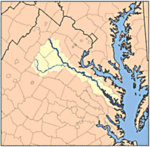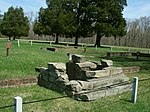The Battle of Chancellorsville, April 30 – May 6, 1863, was a major battle of the American Civil War (1861–1865), and the principal engagement of the Chancellorsville campaign.Chancellorsville is known as Confederate general Robert E. Lee's "perfect battle" because his risky decision to divide his army in the presence of a much larger enemy force resulted in a significant Confederate victory. The victory, a product of Lee's audacity and Union general Joseph Hooker's timid decision-making, was tempered by heavy casualties, including Lt. Gen. Thomas J. "Stonewall" Jackson. Jackson was hit by friendly fire, requiring his left arm to be amputated. He died of pneumonia eight days later, a loss that Lee likened to losing his right arm.
The two armies faced off against each other at Fredericksburg during the winter of 1862–1863. The Chancellorsville campaign began when Hooker secretly moved the bulk of his army up the left bank of the Rappahannock River, then crossed it on the morning of April 27, 1863. Union cavalry under Maj. Gen. George Stoneman began a long-distance raid against Lee's supply lines at about the same time. Crossing the Rapidan River via Germanna and Ely's Fords, the Federal infantry concentrated near Chancellorsville on April 30. Combined with the Union force facing Fredericksburg, Hooker planned a double envelopment, attacking Lee from both his front and rear.
On May 1, Hooker advanced from Chancellorsville toward Lee, but the Confederate general split his army in the face of superior numbers, leaving a small force at Fredericksburg to deter Maj. Gen. John Sedgwick from advancing, while he attacked Hooker's advance with about four-fifths of his army. Despite the objections of his subordinates, Hooker withdrew his men to the defensive lines around Chancellorsville, ceding the initiative to Lee. On May 2, Lee divided his army again, sending Stonewall Jackson's entire corps on a flanking march that routed the Union XI Corps. While performing a personal reconnaissance in advance of his line, Jackson was wounded by fire after dark from his own men close between the lines, and cavalry commander Maj. Gen. J. E. B. Stuart temporarily replaced him as corps commander.
The fiercest fighting of the battle—and the second bloodiest day of the Civil War—occurred on May 3 as Lee launched multiple attacks against the Union position at Chancellorsville, resulting in heavy losses on both sides and the pulling back of Hooker's main army. That same day, Sedgwick advanced across the Rappahannock River, defeated the small Confederate force at Marye's Heights in the Second Battle of Fredericksburg, and then moved to the west. The Confederates fought a successful delaying action at the Battle of Salem Church. On the 4th Lee turned his back on Hooker and attacked Sedgwick, and drove him back to Banks' Ford, surrounding them on three sides. Sedgwick withdrew across the ford early on May 5. Lee turned back to confront Hooker who withdrew the remainder of his army across U.S. Ford the night of May 5–6.
The campaign ended on May 7 when Stoneman's cavalry reached Union lines east of Richmond. Both armies resumed their previous position across the Rappahannock from each other at Fredericksburg. With the loss of Jackson, Lee reorganized his army, and flush with victory began what was to become the Gettysburg campaign a month later.






